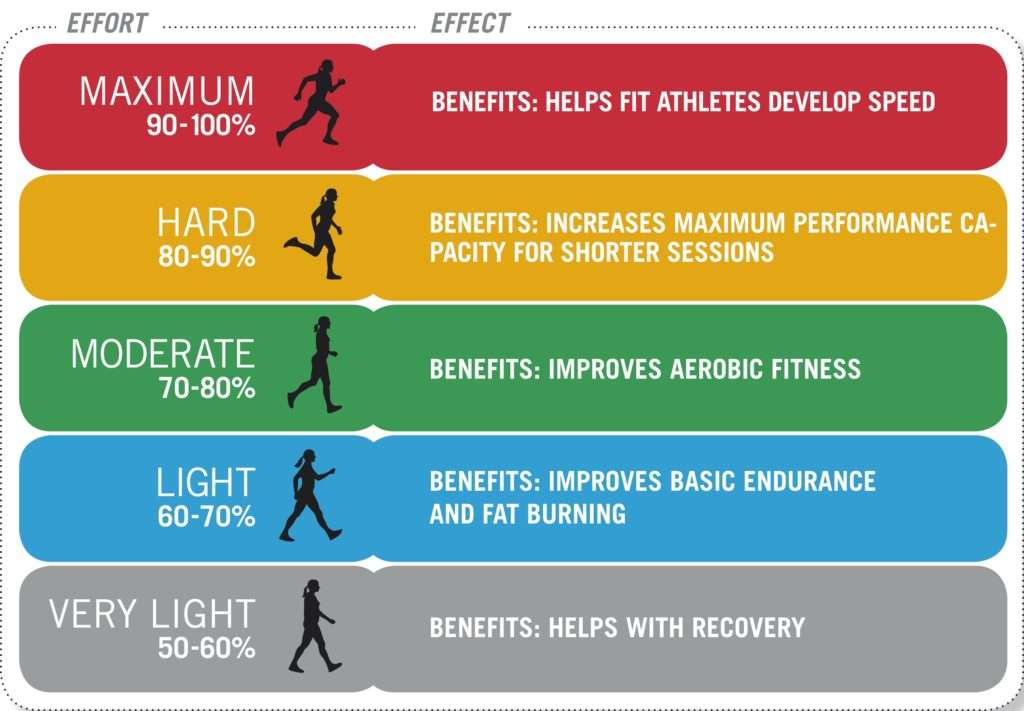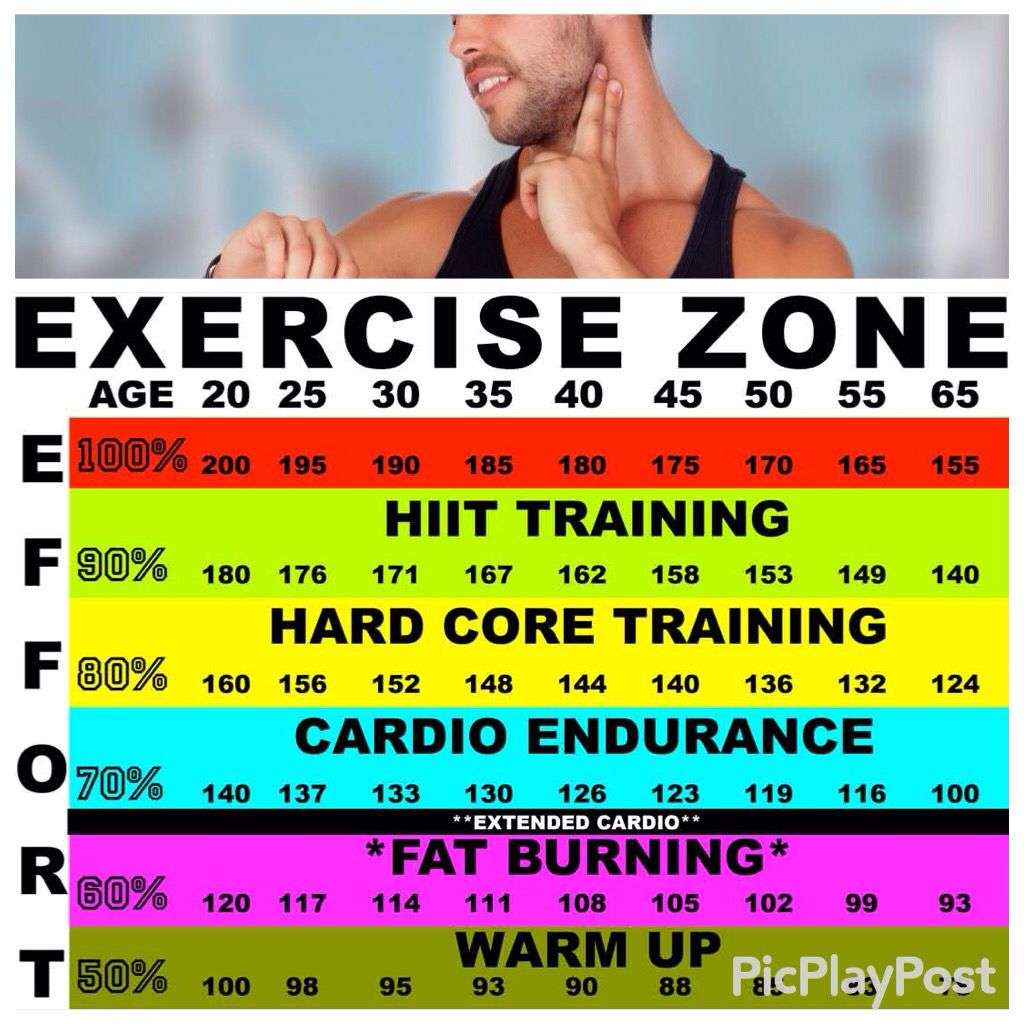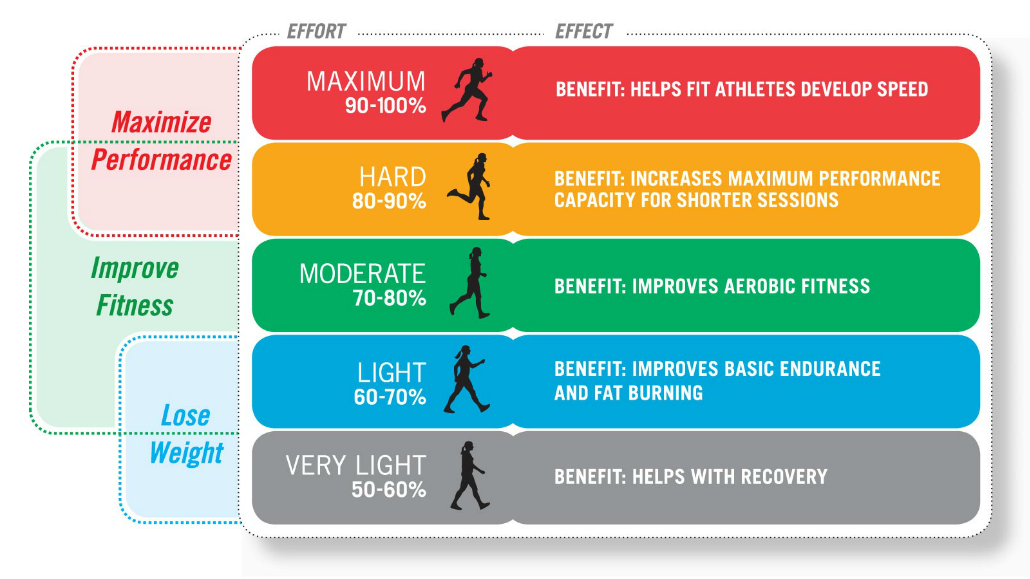Heart Rate Training Zones
Your heart rate training zone is a critical element in exercise. You must train at a variety of different heart rates in order to stimulate your body to improve your fitness level. Taking your pulse and calculating your heart rate during a workout is one of the primary indicators in ascertaining the intensity level at which you and your heart is working.
Zone 1 – Healthy Heart Zone: 50% – 60% of your Max Hr
Easiest, Most Comfortable Zone
Exercise Benefits: Body fat decreases, blood pressure lowered, cholesterol lowered, muscle mass improvements, decreased risk for degenerative diseases, safety high.
Zone 2 – Temperate Zone: 60% – 70% of your Max Hr
Cruise Zone you can train for extended periods of time in this zone 75% – 85% of all calories from fat as fuel, 6 10 calories per minute
Exercise Benefits: Gain muscle mass, lose fat mass, strengthen heart muscle, fat utilization zone, training your fat mobilization, fat transportation, your muscles to burn fat, your fat cells to increase the rate of fat release, increase in the number of mitochondria in the muscle.
Zone 3 – Aerobic Zone: 70% – 80% of your Max Hr
Transition Zone from two health zones to two performance zones still feels comfortable, you will break a sweat, but no anaerobic burn sensation
Zone 4 – Threshold Zone: 80% – 90% of your Max Hr
Max Calorie Burn Zone
Zone 5 – Performance Redline Zone: 90% – 100% of your Max Hr
Peak Race Zone Athlete Only Zone!
Shop
Karvonen Formula For Estimating Hr Zones
There are five heart rate training zones. They are based on the intensity of training with regard to your maximum heart rate. The Karvonen formula is a mathematical equation that helps to determine heart rate ranges for different training zones.
It uses three different variables and looks as follows:
target HR = + resting HR
where:
target HR – heart rate you need to achieve to be in the heart rate training zone;
max HR – maximum heart rate. It’s expressed in beats per minute , and it’s the highest heart rate a person can achieve without experiencing severe problems;
resting HR – resting heart rate. The number of times that your heart beats per minute when you are at rest; and
%intensity – the intensity of the training expressed as a percentage. This value is different for each of HR zones.
The table below presents %intensities for all five of the heart rate training zones:
| Zone |
|---|
Creating Your Heart Rate Training Plan
So now you know what your heart rate zones are, its time to create your training plan. This is something you can easily do yourself, based on the types of workouts you enjoy.;
Your training plan should include a mixture of different cardio workouts that cover each of your heart rate zones. Take the opportunity to think about what you want out of each week and create a mix that will motivate you, especially when you start to see the results.
Unsure how much time you should spend working out each week? The American Heart Association recommends that adults aim for at least 150 minutes per week of moderate-intensity aerobic activity or 75 minutes per week of vigorous aerobic activity, ideally a blend of both. This works out to be a very achievable 22 minutes per day but you can always do more.
Even if youre only interested in one type of training, such as running, its still important to include this variety of workouts to supplement your practice. Add some yoga or drill days to your training plan to enhance your running by building strength and improving your mobility.
The best thing about having a varied training plan is that you can always swap your days around based on how youre feeling. Life doesnt always go according to any plan, so if you havent had a great nights sleep you can do some slow stretches in zone 1 or 2. Having a busy day? Swap your long run for a quick HIIT session in zone 4.;
Read Also: How To Lower My Resting Heart Rate
Determine Your Resting Heart Rate
This is best achieved when you first wake up in the morning. To do this, place two fingertips on your wrist or carotid and take your pulse for one minute. For consistency, repeat this for three consecutive mornings. Add those three readings and divide them by three. This will give you your average RHR.
What Are Heart Rate Zones

We all have a personal resting heart rate, a minimum heart rate, and a maximum heart rate. And between these values are different HR zones that correspond to training intensity and training benefit.
There are different ways to identify your heart rate zones calculation. One simple way is to define them as percentages of your maximum heart rate, and thats what well focus on in this introduction.
Heart rate zones can be defined as percentages of your maximum heart rate.
Heart rate zones are closely linked to your aerobic and anaerobic thresholds. Understanding this can really help when considering heart rate zones exercise, especially your heart rate zones for running or heart rate zone training for weight loss. But first, lets look at what the different zones are.
You May Like: How To Test Heart Rate
Heart Rate Zone Calculator
The heart rate zone calculator finds your five HR zones, which can be used to estimate the intensity of your training. In the article below, you will find information about all the heart rate training zones and a guide on how to measure resting heart rate. You will also get to know the Karvonen formula, which we use to determine target heart rate training zones.
- If you are interested in weight loss , check out our fat burning zone calculator; and
- In case you are a keen cyclist , have a look at our cycling heart rate zone calculator.
We try our best to make our Omni Calculators as precise and reliable as possible. However, this tool can never replace professional medical advice. If you are concerned about your health, please consult a physician.
What Is Target Heart Rate
Your target heart rate is a range of numbers that reflect how fast your heart should be beating when you exercise. A higher heart rate is a good thing that leads to greater fitness, says Johns Hopkins cardiologist;Michael Blaha, M.D., M.P.H.;During exercise, you can monitor heart rate and try to reach this target zone. Doctors also use target heart rate to interpret the results of a cardiac stress test.
Also Check: Elevated Heart Rate When Sick
How To Use Target Heart Rate Zones In A Training Plan
A typical training plan utilizes multiple training zones. You wont train in each zone for an equal amount of time, though. The time you spend in each zone will vary, usually with more time spent in lower heart rate zones. Heres one example of how a training plan might allocate your time spent in each heart rate zone:
Zone 1: 30%-40% of your time
Zone 2: 40%-50% of your time
Zone 3: 10%-15% of your time
Zone 4: 5%-10% of your time
Zone 5: 5% of your time
A typical training plan will designate precisely how much time you spend in each training zone. As mentioned before, not all training plans use the same exact zones. If you were preparing for a 5K or 10K trail running race and wanted to follow this training plan, for example, youd need to set up your device with heart rate zones that are in that training plan.
Maximum Heart Rate Formula
206.9 –
This and MHR prediction equations are the subjects of ongoing;research;since they tend to underestimate;the MHR for older people. That means that if you are older, it may be more accurate to use the zones showed for those who are five to 10 years younger.
For a more customized heart rate percentage, you may wish to use the Karvonen formula which requires you to know your resting heart rate.
If you wear a fitness band or smartwatch that measures your resting heart rate automatically, that can be easily done. An advantage of using these devices to find your target heart rate is that they can be easily updated by the manufacturer to match the current research-backed zones.;
If you want to find your beats per minute for any percentage of MHR, you can use an;online target heart rate calculator. It will also show you the range of heart rate you should be in to be in the entire moderate-to-vigorous intensity fitness zone.
Recommended Reading: How To Connect Heart Rate Monitor To Peloton App
How To Find Your Target Heart Rate
First, it helps to know your resting heart rate, Martin says. Find your pulse . Then count the number of beats in a minutethats your resting heart rate. The average resting heart rate is between 60 and 100, he says. The more fit you are, the lower your resting heart rate; for very fit people, its in the range of 40 to 50 beats per minute.
Target heart rate is generally expressed as a percentage of your maximum safe heart rate. The maximum rate is based on your age, as subtracted from 220. So for a 50-year-old, maximum heart rate is 220 minus 50, or 170 beats per minute. At a 50 percent exertion level, your target would be 50 percent of that maximum, or 85 beats per minute. At an 85 percent level of exertion, your target would be 145 beats per minute. Therefore, the target heart rate that a 50-year-old would want to aim for during exercise is 85 to 145 beats per minute.
But theres an easier way to figure it out if you want to skip the math: Wear a fitness tracking device, or exercise on a treadmill or other machine that calculates target heart rate for you, Blaha suggests.
How To Check Your Heart Rate
Using a;heart;rate monitor;with a chest strap sensor is the most accurate way to see your heart rate continuously during exercise.
Heart rate monitors can be linked to a mobile app or wrist display to alert you when you are in your chosen heart rate zone. Many fitness bands and smartwatches also have this feature. They use LED sensors to detect your pulse while you exercise.
Read Also: How To Stop Heart Palpitations Due To Anxiety
How Do I Get My Heart Rate In The Target Zone
When you work out, are you doing too much or not enough? Theres a simple way to know: Your target heart rate helps you hit the bullseye so you can get max benefit from every step, swing and squat. Even if youre not a gym rat or elite athlete, knowing your heart rate can help you track your health and fitness level.
Know Your Heart Rate Zones In Real Time With Whoop

WHOOP measures your heart rate 24/7 and quantifies the strain your body takes on each day. Every morning, our recovery metric tells you how prepared your body is to take on strain. And when you track your activities with the WHOOP Strain Coach, you can see in real time which heart rate zone youre in, so youll know exactly when to dial it back, or kick it up a notch.
Share on and
Also Check: Why Does Your Heart Rate Go Up When You Exercise
How To Calculate Your Aerobic Exercise Heart Rate
In doing any physical activity, it is important to know your heart rate in order to achieve the best results. Aerobic exercise heart rate is recommended to reach 85% of the maximum heart rate for 20 to 30 minutes. Offers from BestTreadmillAustralia.com.au will help you reach your fitness goals within the recommended heart rate in accordance with your exercise routine, age, workout intensity, and cardiovascular system.
Calculate Your Target Heart Rate
Using the above results, you can now calculate your target heart rate using this formula:
- + Resting Heart Rate Lets take the example of a 40-year-old man. His MHR will be 206.9 = 182.1 bpm. Now, assuming that the RHR is 72, then the target heart rate will be:
- At 50 percent target heart rate + 72 = 127 bpm
- At 85 percent target heart rate + 72 = 165 bpm As you can see, the target heart rate zone falls between 127 bpm to 165.5 bpm.
Recommended Reading: How To Slow Your Heart Rate
Example Heart Rate Zones
The chart below illustrates the results obtained from the Heart Rate Zone calculator for a healthy 50 year old male with a predicted MaxHR of 178bpm.
Most of their training time should be spent in HR Zone 3 to improve cardiovascular performance and aerobic endurance.
For Recovery sessions a majority of their time should be spent in Zone 2.
For Speed endurance training and improving sprint performance short periods of time need to be spent in HR Zones 4 and 5.
Know Your Maximum Heart Rate
Your maximum heart rate is the fastest rate at which your heart will beat, measured per minute. The MHR varies from one person to another it reduces with age. For a long time, most people were using the traditional formula of 220 minus age. However, there were flaws, one of them being that it didnt reflect the changes in heart rate as one aged. After long research, scientists came up with a formula to calculate your MHR:
- Maximum Heart Rate Formula = 206.9 Important facts to know about MHR:
Don’t Miss: How Is A Heart Attack Treated
Choose Your Training Zone
Many runners will train in the 60-70% zone quite frequently. Running in this zone seems easy enough but it still builds endurance; It is also called the recovery zone.
If you are training for a marathon, you will want to be in the 70-80% range more often. The pace is faster, but it is still constant. This zone is excellent for cardiovascular training.
For speed work or interval training, try to train at about 80% of your maximum heart rate. This is the area where the effort is greatest.
Benefits Of Heart Rate Training
As a general rule, most athletes will want to train in varying zones of max heart rate at different times, both within specific workouts and from one to the next. A typical one-hour session might include 10 minutes in the 50-60% target zone warming up and cooling down, 30 minutes at a sustainable pace at 60-70%, 12 minutes pushing a little more at 70-80%, 6 minutes going hard at 80-90% and 2 minutes all-out at 90-100%.
Monitoring your workout heart rate can help you avoid training too hard by knowing exactly when youre overexerting yourself. It will also allow you to bounce back faster by ensuring you stay in the proper zone on recovery days.
Additionally, heart rate training enables you to moderate external factors like heat and humidity, or better adjust on days when you may not be fully recovered. In these cases, your standard workout may be increasing your heart rate more than usual.
Don’t Miss: Does Your Heart Rate Increase When Pregnant
How To Use These Zones For Your Training:
Your intensity and your zones will depend on your health, performance, goals, and workout preferences. Here are a few examples of how HR zones may be used for different goals:
Fat Burning Zone = 50-75% of MHR
- Primarily using fat as a fuel source
Aerobic Fitness Training Zone = 70-85% of MHR
- Heart rate required to improve aerobic endurance
- Primarily using carbohydrate as fuel source
Anaerobic Training Zone = 85-95% of MHR
- Will improve your V02 max and lactate threshold
- Used for sport specific training
- Primarily using carbohydrate as fuel source
How To Calculate Your Training Heart Rate Zones

Heart-rate training benefits everyone, from the beginning exerciser trying to lose weight, to individuals trying to improve their cardiovascular fitness, to the highly conditioned athlete preparing for the next competition.
The key to making progress is to elevate your heart rate into the correct training zone, so your effort matches your goals.
Here are seven easy-to-follow steps that will help you calculate your ideal heart-rate training zone.
Don’t Miss: What Causes Heart Rate To Spike
Heart Rate Tips To Keep In Mind
- Start at your beginning.;Before getting overly concerned about your heart rate, Martin says, its best to simply get moving. If you havent exercised much before, start where youre comfortable and gradually exert yourself more over time.
- Listen to your body.;Your body provides other indicators of how hard its working that you need to consider along with heart rate. Pay attention to how hard youre breathing or sweating, and stop if you feel very uncomfortable, Martin says. Devices recording your heart rate have been known to malfunction, for exampleanother reason listening to your body is important.
- Remember that target heart rate is just a guide.;Dont get overly fixated on numbers, Martin says. Ideally, they just push you to work a little harder.
Training Thresholds And Calculating Working Heart Rate
Training is effective when it specifically targets the individual athlete. One way of achieving this is by targeting the most relevant training threshold. For many athletes this involves calculating a specific working heart rate.
Maximum heart rate = 220 age
A 20-year-old athlete might want to calculate their maximum heart rate in order to accurately calculate their training threshold:
Maximum heart rate = 220 20
Maximum heart rate = 200 beats per minute
Once we have calculated the maximum heart rate, we can calculate the training thresholds.
Recommended Reading: Heart Rate When Having A Heart Attack
